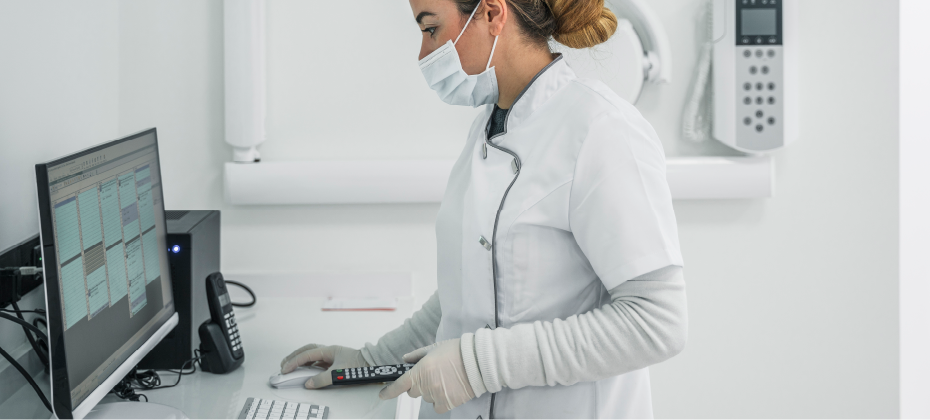Collections Optimization
Boost revenue, streamline patient financial assistance, and reduce collection costs.

Financial recovery after COVID-19 is likely to be a slow burn for most healthcare organizations, according to a recent survey. Nearly 90% of healthcare executives expect revenue to drop below pre-pandemic levels by the end of 2020, with one in five anticipating a hit greater than 30%. While the return of elective procedures will be a lifeline for many hospitals and health systems, the road to financial recovery remains fraught with obstacles: Five months of canceled and postponed procedures need to be rescheduled Worried patients must be reassured of hygiene measures, so they feel safe to attend appointments Patient intake and payment processes must be modified, in order to minimize face-to-face contact As the rate of infection continues to grow, providers must find new ways to also grow their revenue and protect against a further dent in profits. The healthcare industry is unlikely to see the recovery curve hoped for across the wider economy, but digital technology, automation and advanced data analytics could help provider finances to bounce back more quickly. 4 ways technology can accelerate your post-pandemic financial recovery 1. Easy and convenient patient scheduling unlocks your digital front door Patients want to reschedule appointments that were postponed or canceled over the last few months. To manage the backlog and minimize pressure on staff, consider using a digital patient scheduling platform, so patients can book their appointments online. A self-scheduling system that incorporates real-time scheduling and calendar reminders will help to create a positive consumer experience, while offering analytics and behind-the-scenes integration to keep your call center operations running smoothly. 2. Secure and convenient mobile technology can enhance your telehealth services Telehealth is the top choice for many hospitals looking to boost revenue growth and counter the impact of COVID-19, with two-thirds of executives expecting to use telehealth at least five times more than before the coronavirus hit. Many new digital tools and strategies designed to improve the patient journey as a whole can support telehealth delivery, and help to meet growing consumer demand for virtual care. For those beginning their telehealth journey, our COVID-19 Resource Center, which offers free access to telehealth payer policy alerts, may be the place to start. 3. A digital patient intake experience can lessen fears of exposure Although many providers are starting to open up for routine in-person appointments again, patients may wonder if it’s safe. Proactive communication about the measures in place to protect staff and patients will be essential. Another way to minimize concern is to allow as many patient intake tasks as possible to be completed online. Automating patient access through the patient portal can give patients quicker and more convenient ways to complete pre-registration, while contactless payment methods are a safe way to settle bills without setting foot in the provider’s office. 4. Optimize collections to bolster financial recoveryAutomation can also play a huge role in helping providers tighten up their revenue cycle, find new ways to enhance accounts receivable collections and avoid bad debt. Tools such as Coverage Discovery and Patient Financial Clearance enable providers to find missing or forgotten coverage, and help the patient manage any remaining balances in a sensitive and personalized way. Palo Pinto General Hospital uses automated coverage checks to find out whether a patient is eligible for charitable assistance within three seconds, so self-pay accounts can be directed to the most appropriate payment plan before the patient even comes in for treatment. With fewer accounts being written off, Palo Pinto has seen a noticeable improvement to their bottom line. The pandemic has been a wake-up call for an industry that has been traditionally slow to adopt new technologies. Ahead of a second wave of COVID-19, providers must move now to take advantage of automation and digital strategies to speed up financial recovery. Contact us to find out how we can help your organization use technology to improve the patient experience, increase efficiencies and kickstart your revenue cycle.

With a vaccine for COVID-19 thought to be at least a year away, healthcare providers are steeling themselves for even more cases in the fall. The big worry is that a surge in cases will hit the health system just as flu season takes hold. In a recent interview, Dr. Robert Redfield, Director of the Centers for Disease Control and Prevention (CDC), warned that “the assault of the virus on our nation next winter [may] actually be even more difficult than the one we just went through… we’re going to have the flu epidemic and the coronavirus epidemic at the same time.” Healthcare organizations are accustomed to an influx of sick patients between October and March: around 62,000 people died and more than 700,000 were hospitalized during last winter’s flu season. With 130,000 Americans losing their lives to COVID-19 in just four months, what could happen when the two respiratory diseases collide? Large numbers of patients with either virus (or potentially with both) will put renewed pressure on staff and services that are already under immense strain. Hospitals will need to prepare to manage both groups of patients as efficiently and safely as possible. Five ways to ease stress, paperwork and patient concerns ahead of a dual epidemic 1. Use data to drive your patient engagement strategy Create a flu preparedness patient engagement strategy to keep patients informed of how best to protect themselves in the context of a dual epidemic. As a result of the coronavirus pandemic, patients may be more familiar with telehealth services as a “contact-free” alternative to in-person appointments, so you’ll want to continue to promote these to minimize the spread of infection. With consumer data, you can segment patients according to risk and automate your communications, so they get the most relevant message at the most convenient time. 2. Relieve pressure on staff with automated patient scheduling Digital scheduling gives patients the option to book appointments online, at a time and place that suits them. This reduces pressure on call center staff and can give providers control over the volume and timing of in-person appointments, thus helping to reduce the spread of germs. An online patient scheduling platform can automate the entire scheduling process, integrating in real-time with your records management systems and connecting to your referral providers’ systems for a seamless patient and staff experience. 3. Screen patients proactively to discover their needs ahead of time Asking patients to fill out electronic questionnaires before their visit means their access needs can be identified and addressed before they come in. Do they need help to find transportation? Will they face any challenges in picking up a prescription? Is there something that could stand in the way of follow-up care? Screening for social determinants of health can answer these questions so you can direct patients to the most appropriate care and support. 4. Enable digital patient registration for a quick and easy intake experience Speed up the registration process by giving patients the option to complete their intake admin by phone or through their patient portal. Not only will this reduce the spread of infection in busy waiting rooms, it’ll make for a more enjoyable patient experience and free up limited staff resources for other priorities. With automated registration and consumer-facing mobile experiences, you can improve the patient experience, operational efficiencies and data accuracy all at the same time. 5. Minimize in-person interactions with contactless payments Encourage patients to clear their balances without having to hand over cash or access payment kiosks. Self-service digital payment tools allow patients to make contactless payments through their patient portal or from their mobile device. “The combined pressure from two viruses hitting health systems at once means it’s even more important for providers to leverage data for speed and accuracy. Automated workflows can help accelerate operational efficiency, as well as create a better patient experience during what’s already an extremely stressful time.” Victoria Dames, Vice President of Product Management for Experian Health Find out more about how Experian Health’s expertise in data and analytics can help your organization prepare for the coming flu season so you can offer your patients a safe, accessible and stress-free experience. We have also developed a checklist of action items for providers to consider as you prepare for both flu and COVID-19. How ready are you? Which actions is your organization instituting now?

By January 2021, millions of those who suffered job losses in the wake of COVID-19 will see their unemployment insurance end. Medicaid and subsidized coverage under the Affordable Care Act (ACA) will be a safety net for many, but nearly 2 million Americans could find themselves stuck in the ‘coverage gap’, where their household income exceeds the eligibility threshold for Medicaid, yet falls below the lower limit required to receive ACA marketplace subsidies. Without large group or government coverage, these consumers will be left uninsured or forced to purchase individual plans with high deductibles. Considering this will likely contribute to larger patient balances and more struggles with patient collections, many are bracing for a hit to their bottom line. To help minimize accounts receivable and avoid bad debt write-offs, choosing the right data model should be a top priority. Here, we look at one piece that’s often missing from the patient collections puzzle: credit data. Don’t overlook credit data in your self-pay collections strategy Many providers already use demographic and behavioral data to power patient collections, but there can be gaps in what’s known about a consumer’s ability to pay. Credit data can help fill in the blanks. Here are three ways this can be used to optimize your collections strategy: 1. Get a complete view of your patients’ financial situation for faster decision-making Credit data can reveal how a patient is managing other financial obligations, giving you insights about how to handle their healthcare account for a greater chance of payment. Have they just maxed out a credit card? Have they missed a student loan payment or fallen behind on their mortgage? If so, they’re probably going to find it difficult to pay off their medical bill. Knowing this, you can move quickly to help them find alternative coverage or offer a more manageable payment plan. Conversely, if they’ve just bought a new car or paid off a personal loan, there’s a high chance they’re in a good position to pay their medical bills too, so contacting them with a straightforward and easy payment plan means they can clear their balance promptly. 2. Segment patient accounts and allocate them to the right payment pathway The sooner you can get patients onto the right payment pathway, the more robust your cashflow will be. Credit data can help you segment accounts quickly and accurately. Experian Health data shows that when patients are segmented according to propensity to pay, collections increase by around 2% when credit data is included, compared to segmentation without credit data. Novant Health used Collections Optimization Manager to segment patients and check for available charity support or Medicaid eligibility. By getting patients on the right pathway and making sure agencies were focusing on the right accounts, they increased recovery rates by 5% and saw a rolling average return on investment of 8.5:1. 3. Create a more compassionate patient financial experience Using credit data also helps create a more compassionate patient financial experience. Instead of adding to a patient’s financial worries by chasing payments they’ll never be able to cover, you can run charity checks to see if there’s any missed coverage and quickly connect them to the right financial assistance program. A tool such as Collections Optimization Manager lets you segment patients based on their individual circumstances, for a more patient-friendly approach to collections. You can then personalize their communications and payment options so they can manage their expenses with less anxiety and more confidence. Discover why 60% of US hospitals are already using Experian Health’s advanced collections software and unrivaled datasets to optimize patient collections, and find out how we can help you build a resilient revenue cycle as self-pay accounts continue to rise.

Medical expenses are often a source of anxiety for many patients, whether they are unsure about the amount owed or how they’ll ultimately pay for it. Unfortunately, intimidating collections processes don’t help, and a crisis like COVID-19 only exacerbates this stress. A more compassionate billing approach could help patients better navigate their financial obligations and also build long-term loyalty—a necessity for providers today looking to retain patient volume during a time of crisis. Consumers overwhelmingly want to understand the cost of healthcare services, prior to services being performed. Effective price transparency involves offering patients clear, accessible, and easy-to-understand estimates of their financial responsibility for services before they are performed. Give patients clarity from the start with precise pricing estimates and up-front info about what they’ll have to pay can reduce sticker shock, help them plan and create an overall better patient financial experience. By empowering your patients with financial expectations, their feeling of control increases, improving their engagement and the likelihood that you will collect payments faster and more efficiently. Just as you don’t provide identical medical treatment to every patient, processing all patient accounts the same way doesn’t make sense. Every patient is different. Using comprehensive data and advanced analytics, providers can better understand an individual's propensity to pay and make the payment process a positive one by assessing and assigning each patient to the appropriate financial pathway based on their unique financial situation. Medical bills are often the most direct contact providers have with patients after a service is rendered. Unfortunately, money is often a sensitive topic for patients and statements are often overwhelming and difficult for patients to read. Tailoring communications at each stage can convey compassion and increase patient satisfaction. Customizing patient statements gives providers the ability to simplify and customize bills quickly and easily, turning an often confusing process into one that adds value. Including relevant, personalized messages and educational updates can turn billing statements into a useful resource, all with the potential to drive revenue. In addition to offering personalized payment options, providers can also find out whether a patient prefers to discuss billing by phone or email. Minimizing friction at the point of payment is crucial to fostering compassionate collections. Providers should offer flexible options that include in-person, telephone, mobile and online patient portals, so they can pay in a way that’s most convenient for them. This also frees up staff to help those patients who may need a little extra help understanding their statement. Want to learn more? Check out Experian Health’s Collections Optimization Manager which helps providers segment patients based on an individual’s propensity to pay and payment preferences, informing a compassionate patient engagement strategy and improving collections.

Patients today expect digital capabilities from their provider and will increasingly choose those who offer digital capabilities. Knowing this, many providers have been working to shift more of the patient journey online, through telehealth and virtual care. Not all care needs to be delivered face to face, and technological advances allow patients to access more services from the comfort of their own homes, at a time that suits them. This trend has been visible for a few years now, as consumers sought out more smartphone-friendly digital healthcare experiences. But change in the healthcare industry often comes at a lumbering pace, so when the coronavirus pandemic hit and accelerated the transition to remote care, many organizations found themselves on the back foot. Now, it’s a case of catch-up, keep up or get left behind. As demand for telehealth services grows, so too does the regulatory framework around it. A big part of staying competitive will be the ability to keep track of new telehealth regulations and changing payer rules. Those that don’t will find their collections straining under the added pressure of missed reimbursement opportunities. How can providers stay on top of the changes and maximize reimbursement? Keeping track of telehealth reimbursement regulations Since early March 2020, the federal government has moved to make telehealth more accessible to patients with Medicare coverage. Limitations on the types of clinicians that can provide telehealth services under Medicare have been waived, while Medicare beneficiaries in rural areas and those with audio-only phones can now access care remotely. New telehealth services will be added to the reimbursable list under a quicker process, which is a huge benefit to both patients and providers, but will mean the rules around reimbursement could change more frequently. Speaking in March, CMS Administrator Seema Verma said: “These changes allow seniors to communicate with their doctors without having to travel to a healthcare facility so that they can limit risk of exposure and spread of this virus. Clinicians on the frontlines will now have greater flexibility to safely treat our beneficiaries.” Flexibility is always welcome – but what do looser rules mean for reimbursement workflows? Three challenges stand out: Payer variation. Telehealth and telemedicine data can be presented differently by different payers, causing a headache for providers during eligibility verification. Coding variation. Each type of telehealth visit is coded and billed differently. Regardless of where appointments are carried out, clinicians must still follow the same billing workflow, so keeping track of the differences is essential. Geographical variation. Providers now have to track billing and coding changes for telehealth services from different payers across multiple states. What can providers do to bill telehealth services as accurately as possible? Billing for telehealth services more frequently calls for a solution that’s flexible enough to keep pace with changing payer rules, and sufficiently scalable to provide real-time reimbursement information when it’s needed. Automation can help achieve both of these goals. Two use cases for automation: Quicker Medicare checks: Run quick and accurate checks to confirm patients are eligible for Medicare coverage for the services in question. A tool such as Coverage Discovery can comb for available coverage, even as patients are switching plans or payer rules are changing. In addition, eligibility verification automations can sweep for coverage information on telehealth services, using reliable and secure third-party data and analytics to check for updates. Cleaner claims submissions: Tighten up billing workflows so that claims can be submitted as soon as possible. Claims management software can run automatic checks so that every claim is submitted clean and error-free. Any missing or incorrect codes can be flagged up, eliminating costly and time-consuming rework. Telehealth alerts can be included as customized edits to confirm whether virtual care is a benefit included in the patient’s current plan. While these actions can help protect your bottom line during the immediate crisis, they’ll also help you build a solid foundation as your telehealth offering inevitably continues to grow. Whether you’re looking to verify coverage, check eligibility or protect patient identities as they log in and use telehealth services, reliable data is key. Schedule a free consultation to discover how Experian Health can help you leverage accurate and real-time data insights to optimize your billing workflow and maximize telehealth reimbursements.

At the beginning of the year, the healthcare industry moved away from Medicare identifiers based on Social Security Numbers (SSNs), in favor of more secure Medicare Beneficiary Identifiers (MBIs). As with any large-scale change program, the shift was unlikely to be completely clear sailing. But with the coronavirus pandemic landing shortly after the 21-month transition period was due to conclude, the switchover has been rougher than expected. Impacted Care Care providers are discovering newly eligible Medicare beneficiaries who haven’t yet received their card, while existing beneficiaries have misplaced theirs. Without a valid MBI number, patients risk delayed access to care, while the admin process to sort it out can be stressful, especially for already-vulnerable senior populations. For providers, the extra work and delayed reimbursements are particularly unwelcome when COVID-19 is already putting pressure on services and squeezing revenue. Unprecedented intake conditions where staff and patients are trying to limit face-to-face contact makes it difficult to complete the usual coverage checks. As a result, providers are missing revenue opportunities they cannot afford, while incurring additional downstream costs when collections are delayed. Experian Health clients are optimizing Coverage Discovery to speed things up. Case study: how one healthcare provider is finding missing Medicare coverage faster For example, the southeast division of a national health care system, with 1700+ beds and $1.6B in revenue, needed better ways to find MBIs when Health Insurance Claim Numbers (HICNs) were phased out. Assisting Medicare patients with tracking down their MBIs was time-consuming and error-prone. They came to Experian Health to find a more efficient way to check Medicare coverage. Jason Considine, Experian Health’s Senior Vice President for Patient Collections and Engagement, says: “We knew we could help because we already had Medicare coverage history through our historical repository. As a test, we were given a control set of known Medicare patients without MBIs, and were charged with finding those patients’ MBIs and Medicare coverage.” Experian Health’s Coverage Discovery tool was used to batch-process the control set. This took less than a day, as the tool scans more than one million accounts daily, using historical and demographic data, synthesized with multiple proprietary data sources, to find unknown or forgotten coverage. In this case, the resulting data was collated via batch files, but could be integrated with other coverage and collections tools, such as eCareNext, which automates the more repetitive and hands-on pre-registration tasks. Coverage Discovery found 60% of the Medicare coverages with MBIs, plus additional coverages. This enabled the provider to file claims that would otherwise have been nearly impossible and very time consuming. The provider’s next steps will be to integrate Coverage Discovery with eCareNext, and roll it out to more of sites in the system. Could Coverage Discovery help your organization find missing MBIs? Capturing better insights into productivity, financial results, and staff workflows is always valuable. But in the current crisis, tool that maximize reimbursement and automating the tasks that take up staff time is essential. Through our historical data repository, Experian Health’s Coverage Discovery already contains many patient MBIs – and it’s continually updated. We can help you search for Medicare coverage and make sure your clients find their MBIs, easing pressure off your revenue cycle management teams during this extremely challenging time. Request a review of Coverage Discovery and improve your coverage and collections processes.

There’s a phenomenon in online product reviews where the customer seems to love their purchase, yet gives it only one or two stars. Why do they do this? Poor customer service: the item was delivered late, questions went unanswered, or payment processing was disorganized. When the consumer experience falls below expectations, the brand suffers – no matter how good the product. The same thing happens in healthcare. The clinical care may be outstanding, but if the patient finds billing frustrating or confusing, it’s those feelings they’ll associate with the overall experience. Many healthcare providers suffer reputational damage because the patient financial experience fails to match high quality clinical care. This is especially true for patients who find themselves without coverage and in need of financial assistance, which is often an extremely stressful process. And with unemployment levels soaring as a result of the coronavirus pandemic, it’s likely more Americans will need to explore eligibility for charitable support. Finding smarter, speedier and scalable ways to check charity care eligibility is even more important. Using automation for faster charity care checks Automation may be the answer. With a system that runs checks quickly and easily against vast databases of up-to-the-minute records, providers can discover a patient’s propensity to pay before treatment is even carried out. Clarity from the outset ensures the patient is put on the right payment pathway and lays the groundwork for a positive patient financial experience. Caye Mauney, Patient Access Director for Palo Pinto General Hospital, tells us how her organization used data-driven financial clearance checks to improve the patient financial experience and reduce bad debt: Speeding up checks for earlier eligibility decisions Prior to using automation, Palo Pinto General used a time-consuming and labor-intensive paper-based process to determine a patient’s eligibility for charity assistance. But with automated screening prior to or at the point of service, the hospital can now verify whether patients qualify for charitable assistance within three seconds, and quickly connect them to the right program. For those with a self-pay amount, a Healthcare Financial Risk Score can be calculated using historical payments information and credit history, to help determine the optimal payment plan. Mauney says: “All the information we need is now at our fingertips. The patient no longer needs to bring in check stubs or go back to a former employer to ask for information. It’s been a game changer.” Creating a personalized patient experience At Palo Pinto, staff wanted to make sure that patients were taken care of not only medically, but financially too. Just as each patient needs medical care tailored to their individual needs, so too should their financial accounts be handled on a case by case basis. With custom payment plans based on an individual’s unique financial situation, the payment process can be transformed into an experience that patients no longer dread or avoid. Automated patient clearance checks draw on multiple sources of data and run analytics to quickly determine the best option for each patient. It can also generate scripts for patient advocates to use, to help patients navigate the process more easily. Palo Pinto reports improvements in patient satisfaction and trust as a result of uncomplicating the patient experience in this way. Reducing bad debt and increasing point-of-service collections Seamlessly connecting patients to the right financial assistance program allows patients to focus on their treatment, while feeling reassured that their financial obligations will be met. For providers, swift processing means decisions are made quickly, resulting in fewer accounts receivable delays and a lower risk of uncompensated care. At Palo Pinto General, quicker charity applications means more are being approved, and therefore not written off as bad debt – ultimately helping their bottom line. Discover how automating checks for charity care eligibility with Patient Financial Clearance can help your organization increase productivity, improve collections and boost patient satisfaction.

A hundred years ago, the Spanish flu pandemic led to a revolution in public health. Healthcare systems were overhauled, national health surveys were launched, and cross-border cooperation laid the groundwork for what later became the World Health Organization. Now, with everything from grocery shopping to the global economy upended as a result of COVID-19, thoughts inevitably turn to the legacy of the current pandemic. As healthcare providers struggle to reorganize services, staffing and revenue cycles, change is being forced at a blistering pace. Adjusting is tough, but it’s also accelerating technology trends that healthcare has been slow to leverage until now. Could the coronavirus pandemic bring the future of healthcare to us sooner than expected, just like what happened in the years following 1918? What more can providers do to prepare for challenges in the new normal? Here to stay: telehealth and virtual care Necessity drives innovation – and one key example now is the telehealth explosion. Only a few months ago, remote healthcare was a business choice, selected for being more cost-effective and more convenient for patients, and for reducing the service-load on busy physicians, compared to traditional face-to-face care. Today, it’s an operational essential in preventing the spread of the coronavirus, giving patients a safe way to speak to their doctor without leaving their homes. Relaxed regulations, clearer payment rules and a hundreds of millions of federal cash injection are giving the roll-out a helping hand. Not only is this promoting better patient care and mitigating some of the revenue loss from reduced patient visits, it’s giving providers an unexpected opportunity to conduct a large-scale experiment in the use of telemedicine that would otherwise have been impossible. And it’s working. Patients, physicians and providers are getting used to the benefits of virtual care. Telehealth and self-service patient engagement will likely become the norm once the pandemic settles. Future-proofing healthcare services for a post-pandemic world Even though COVID-19 is far from over, now is the time to plan ahead for managing the pandemic fallout and to protect against future risks. As leading trends forecaster Mary Meeker suggests in her coronavirus trends report, what we really need to prepare for the aftershocks of COVID-19 is better integration of healthcare and technology. We already have the tools at our fingertips – and telehealth is just the start. Where are the gaps? Improving contact tracing and syndromic surveillance The medical community highlights contact tracing as essential for getting a handle on the spread of the coronavirus and potential future outbreaks. Unfortunately, we don’t yet have a system of universal patient identification, which could aid disease tracking by monitoring patient interactions with different touchpoints across multiple health services and generally aiding more accurate patient records. Still, many providers are turning to universal identity managers to track healthcare interactions and share accurate patient information safely and securely within their own networks. Prioritizing data protection and security With the surge in remote care and mobile health, keeping patient data safe through robust identity protection and matching is even more important. A tool such as Precise ID can give providers reassurance that only patients engage with their information – whether on their phones or visiting a provider’s health portal – without creating long wait times or adding complexity to the sign-up process. Strengthening the revenue cycle Estimates suggest health systems could lose an average of $2,800 per COVID-19 case, with many losing up to $10,000, if payers do not raise reimbursement premiums. Ceasing revenue-generating services to accommodate COVID-19 cases only compounds the financial strain on the healthcare system. With revenue cycles at breaking point, there is no room for inaccurate coding or claim denials. To help hospitals and healthcare organizations stay on top of rapidly changing payer policies, Experian Health is offering free access to COVID-19 and telehealth payer policy alerts, so providers can avoid delayed payments and costly claim denials. While the 1918 pandemic led to a complete revolution in our understanding of public health, the legacy of this virus may be more of an evolution – accelerating technological progress already moving forward. The organizations that adapt the quickest to the new normal will be most likely to survive. Find out more about the free resources and support available through Experian Health’s COVID-19 Resource Center to help your organization tackled the most pressing COVID-19 concerns.

There is no doubt the healthcare industry has taken a financial beating as a result of COVID-19. But there is a glimmer of hope for providers. Several new announcements were recently made attached to the Coronavirus Aid, Relief, and Economic Security (CARES) Act, specifically around reimbursements attached to COVID care for the uninsured. The financial stimulus, intended to stabilize hospital finances as providers face short-term revenue reductions due to the cessation of non-urgent procedures and the increased costs for personal protective equipment, has earmarked a portion of the $100B established for CARES to reimburse healthcare providers at Medicare rates for the treatment of uninsured COVID patients. The guidance does not indicate specifically how much money will be set aside to reimburse these claims. The big question? How long will the funds last and how quickly will providers act? With both unemployment, translating into more uninsured individuals, and COVID cases on the rise, the dollars could be exhausted quickly. A recent study by Kaiser estimates the total payments to hospitals for treating uninsured patients under the Trump administration policy would range from $13.9B to $41.8B. While Medicare payments are about half of what private insurers pay on average for the same diagnoses, estimates surrounding COVID care can be in excess of $50k for those severe cases where struggling patients spend weeks in the intensive care unit on a ventilator. Bottom line, it’s likely the funds will be distributed quickly, especially when factoring in unemployment skyrocketing. As of April 30, more than 30M Americans have filed jobless claims amid the coronavirus outbreak. The all-new portal opened on April 27 for sign-ups, and providers can begin submitting claims electronically on May 6. Healthcare providers who have conducted COVID-19 testing of uninsured individuals or provided treatment to uninsured individuals with a COVID-19 diagnosis on or after February 4, 2020 can request claims reimbursement through the program electronically and will be reimbursed at Medicare rates, subject to available funding. A complete list of FAQs regarding the CARES Act and reimbursements are accessible on the Health Resources & Services Administration website. But what other tips and considerations should providers contemplate as they attempt to get their fair share? Here are three actions to optimize a provider’s chances of claiming reimbursements for the uninsured. Automate the insurance check. Providers must attest that they have checked for healthcare coverage eligibility and confirm the patient is uninsured. If they fail to check, they may be denied. Providers must verify that the patient does not have coverage such as individual, employer-sponsored, Medicare or Medicaid coverage, or any other payer options that will reimburse for the COVID-19 testing and/or care of that patient. There are ways to automate this step, completing a second eligibility check to attest that the patients have no coverage before providers submit claims to the government. Scan for the social security number (SSN), if possible. While there may be instances where COVID patients entered a facility and were quickly admitted with no formal registration process, the CARES Act states an SSN and state of residence, or state identification/driver's license is needed to verify patient eligibility. If these pieces of information are not captured, providers need to attest that they have attempted to capture this information before submitting a claim. The patient may be long gone, but there are still ways to attempt to retrieve a patient’s SSN after they have exited the healthcare facility. Providers should know that claims submitted without an SSN and state of residence, or state identification/driver's license may take longer to verify for patient eligibility. Again, with the possibility that these funds could quickly be exhausted, it is in the provider’s best interest to submit claims that are as clean and validated as possible. Act fast. Recall the Small Business Administration's Paycheck Protection Program (PPP) — a coronavirus relief fund for small businesses that was also established under CARES? The $350B allocated by the bill was quickly depleted in days. While these funds were going to individuals in entirely different industries, there is no concrete projections on how long healthcare providers can expect the $1B fund to cover reimbursements for the uninsured. So, providers need to act now, and fast, by tapping into automation and auditing solutions that will optimize their chances of securing their fair share.